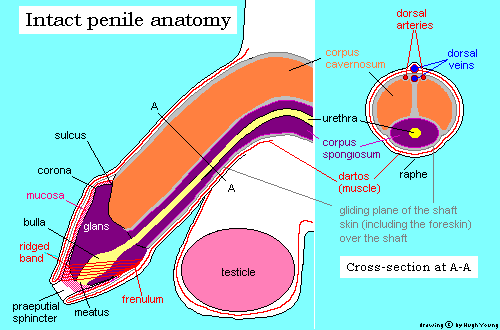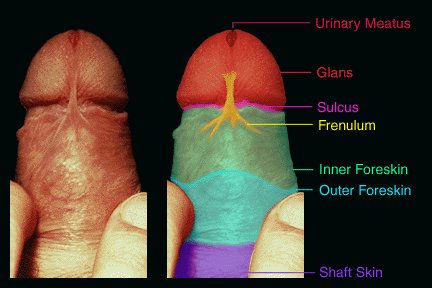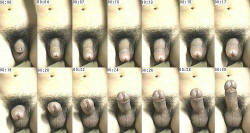|
|
|
|
Well, assuming that your anatomy is more-or-less average, you'll know what a penis looks like - at least, you know what a circumcised or an uncircumcised penis looks like, depending on what happened to you soon after you were born. But the penis is a very variable organ, perhaps even the one that varies more than any other in the human body, and so unless you have had some experience of sex with men, you may not have seen the huge variety of size and shape between men. Having said that, if you can get an erection, masturbate and ejaculate, enjoy sex and urinate normally, and you have no infections, phimosis or other problems, then you really don't have anything to worry about. Here's a diagram of the uncircumcised penis: Basic anatomy of the uncircumcised penis
Your penis is basically a very specialized roll of flesh with a hollow tube down the middle. This tube, the urethra, is the passage to the outside world for urine and semen.
It normally opens as either a small round hole or a long narrow slit on the tip of the glans, although some men have a condition called hypospadias, where the urethra opens somewhere on the underneath of the penile shaft. Often there are two little lips surrounding the end of the urethra on the glans. These lips are full of nerve endings which can provide immense excitement during sexual play. The glans is the most sensitive part of the penis, as you'd expect, since it leads the way into the vagina during sexual intercourse. Both the coronal ridge of the glans and the frenulum seem to be important in stimulating ejaculation during intercourse. The frenulum is one of the most sensitive spots on the entire penis, but it is often cut away during circumcision. And Hugh Young, of Intactivism, points out that the foreskin, also removed during circumcision, may actually be more pleasure-sensitive than the glans. If you want to see some of the unfortunate (and not uncommon) harmful consequences of circumcision, check out the photos here. Inside the penile shaft, the urethra is surrounded by spongy tissue called the corpus spongiosum. During sexual arousal, a network of small arteries fills the corpus spongiosum with blood. This blood cannot escape because the veins near the base of the penis are constricted by the swelling of the spongy tissue of the corpus spongiosum. In the diagram above you can see that there are two other channels of spongy tissue in the penile shaft, each known as a corpus cavernosum, and these also fill with blood during an erection. As the amount and pressure of blood in the penis increases, an erection begins to develop. If sexual arousal continues, the continuing constriction of the veins traps more blood inside the penis and the erection proceeds to full firmness. If the penile arteries become blocked by fatty deposits or the veins leak, a man is likely to develop impotence or erectile dysfunction - which means he cannot get an erection or maintain one. See this site for more details. Unfortunately, as a man ages, the blood supply to his penis can decrease because of the increased amounts of fat which are deposited in his penile arteries - and it doesn't take much to block them, for they are very small in diameter. Such reduced blood flow slowly causes the muscle fibers inside the penis, whose job is to regulate blood flowing through the blood vessels, to degenerate into connective tissue. The greater the amount of connective tissue, the greater the difficulty getting an erection - eventually it will be impossible to get an erection at all. There can also be an apparent reduction in penis size as a man gets older - partly due to this change in tissue structure, and partly due to the amount of fat around his abdomen increasing, so that the base of his penis shaft is less obvious and its apparent size becomes shorter. Even in a penis with clear arteries, it seems that normal blood flow may not be sufficient to keep the internal tissues healthy, and some doctors have suggested that the function of spontaneous erections during sleep is to ensure good oxygenation of the penis through increased blood flow. In short, it seems that the more erections you have, the healthier your penis will be! It certainly seems logical to me that regular erections are both natural and necessary for ensuring optimum health and maximum size. The penis goes deep back inside the body, with its "root" reaching back underneath the prostate gland towards the anus. This hidden penile tissue is very sensitive, and stimulating it during sex with fingertip pressure applied either through the scrotum or on the perineum (the area between scrotum and anus) can be very pleasurable. A lot of men have a penis which shows little or no shaft outside their body when they are not sexually aroused, and it is this hidden part of the penis which can generate a sizeable erection when they become sexually aroused. This is described in greater detail on the size page of this website. You may have noticed a line along the underside of your penis. This is the "raphe". As you developed in your mother's uterus, your penis formed as a tube of flesh which gradually sealed along its length. Normally, the only sign of this process after birth is this thin ridge of skin along the underside of the penis. The skin of the penis contains muscle fibers which extend from the muscles of the scrotum. These muscle fibres control whether you have a scrotum which hangs loosely, or one which is held tighter against your body. The more active the muscle, the tighter and more crinkly your scrotum appears. The frenulum is regarded as a nerve site trigger for ejaculation. It'd be interesting to know if more circumcised men (a higher proportion of whom have lost the frenulum compared to uncircumcised men) show slowness in ejaculating than do uncircumcised men. Of course, cold water and fear can also cause the muscles to contract, and, as you know, your penis and scrotum will then shrink and appear much smaller. The length of the foreskin is highly variable, so that in some men there is only partial coverage of the glans, even when the penis is flaccid. As we said before, the frenulum is one of the most sensitive parts of the penis, but it is often removed during circumcision, along with the foreskin. There's a picture below of what the frenulum looks like on an uncircumcised man with his foreskin retracted. Some men are now restoring their foreskins, and we have our own account of one man's foreskin restoration procedure on The-penis.com. Click here to read it. The foreskin is tethered to the shaft of the penis by the frenulum, which stops it retracting too far and causes it to move forward again after it has been pulled backwards.
The outer surface of the foreskin is skin, but the inner surface is a sensitive mucous membrane that contains sebaceous glands which lubricate and protect the glans from friction. Because circumcision removes these lubricating glands, many circumcised men complain that their glans tissue is too sensitive as it rubs against their clothing. Generally, the foreskin is much larger than you might think - it can be up to ninety square centimeters in area in an adult man. Considering how many more nerve cells the foreskin has compared to the glans, one might guess that circumcision destroys a great deal of a man's sexual sensitivity. Finally, the ridged bands on the inner surface of the foreskin near the tip merge with the frenulum and have the highest number of nerve endings of any part of the foreskin. These nerve endings are of a type sensitive to changes in pressure and tension, and are thought to play a part in stimulating and controlling orgasm and ejaculation during intercourse. The rights and wrongs of circumcision are discussed on the next page. One interesting question is whether or not hypospadias can have an impact on sexual functioning. This is a condition where the foreskin may be incompletely formed, leaving a hooded appearance with an incomplete circumference of the foreskin around the glans. The frenulum is usually missing - which may or may not affect a man's sexual pleasure - but the question for most men is really one of appearance and sexual functioning. I have only come across one man with hypospadias who reported that he had delayed ejaculation. After using a treatment for retarded ejaculation he reported that his sexual function was normal - he ejaculated within five minutes - after previously not being able to ejaculate at all. I assume this was caused buy the psychological impact of the hypospadias and increased confidence resulting from treatment. The process of erection - click on the montage for a larger version of a penis moving from flaccid to erect in 30 seconds. Click here for a full account of the mechanism of erection. What is the function of smegma? More than you ever thought you could know about this substance. It collects under the glans and needs to be washed away every day. The prepuce, from the International Journal of Urology A very detailed piece on the anatomy and origins of the foreskin, with an explanation of its development and structure that highlights the downsides of circumcision and draws parallels with the female genital structures. A great, if scientific, piece, full of medical references. Some fascinating stuff here about what the foreskin does, and comments from guys who had it removed. Could the psychological and physical pain of circumcision explain adult male psychology? There may be a lot more to this than meets the eye. Circumcised men may also be subject to greater risk of premature ejaculation, and have to learn how to stop premature ejaculation, or paradoxically may have to use prolonged thrusting during intercourse to adequately stimulate their remaining erogenous penile nerve endings which trigger ejaculation (Bensley & Boyle, 2001). Men who have been circumcised say that the unnatural dryness of the keratinized glans of the circumcised penis can makes coitus painful, causing in chafing and sometimes skin abrasions (Gemmell & Boyle, 2001). Moreover, O'Hara (1999) found that women reported significantly more sexual pleasure from intercourse with uncircumcised men than circumcised men. One explanation is the loss of stretch receptors in the missing prepuce and frenulum and an associated reduction in sexual response, which reduces a circumcised man's ability to achieve full sexual arousal. This also means erectile dysfunction may be a complication of male circumcision (Glover, 1929; Ozkara, Asicioglu, Alici, Akkus, & Hattat, 1999; Palmer & Link, 1979; Stief, Thon, Djamilian, Allhoff, & Jonas, 1992; Stinson, 1973). For full list of references see Cirp.org. Sidebar: Occasionally a yeast infection develops on the genitals, as well as any other area of the body. Indeed, for some women, this is a persistent problem, and one which causes much distress and irritation. It give you information which includes details of the causes of yeast infections, as well as practical treatment approaches, the merits of medical and self-help care, and all other aspects of Candida albicans infection. Anatomy of the penis and mechanics of intercourse y The Circumcision Information Resources Page, with information on everything to do with the penis, its development, both structure and function, sexual diseases and lots more. Even if you're pro-cutting, you'll find good material here, particularly on the anatomy of the penis. There is a searchable database. More information from CIRP includes the subject of how to look after an uncircumcised baby boy's penis, normal development of the prepuce form birth to 18, and so on.... An interesting graphic which shows exactly what it says! National Organization of Restoring Men The organization devoted to restoration of the foreskin by various methods. Lots of information and pictures, with links to many personal sites and diaries of the procedures. Post-Circumcision Sexual Sensitivity Self-Test: How much of your sexual sensitivity has been cut away? A very informative site, with useful information on circumcision for new parents. Also includes the revised position statement from the American Academy of Pediatrics (which now says routine circumcision of babies is not advisable) and emphasizes the need not to cut if a baby boy has hypospadias. A unique tool for curing phimosis at home. You don't need to load the foreign language characters to use the site, just click cancel when the pop up box appears. I can't vouch for it, but it looks interesting. Another page of penile anatomy to help explain the penis and how it operates.
|


